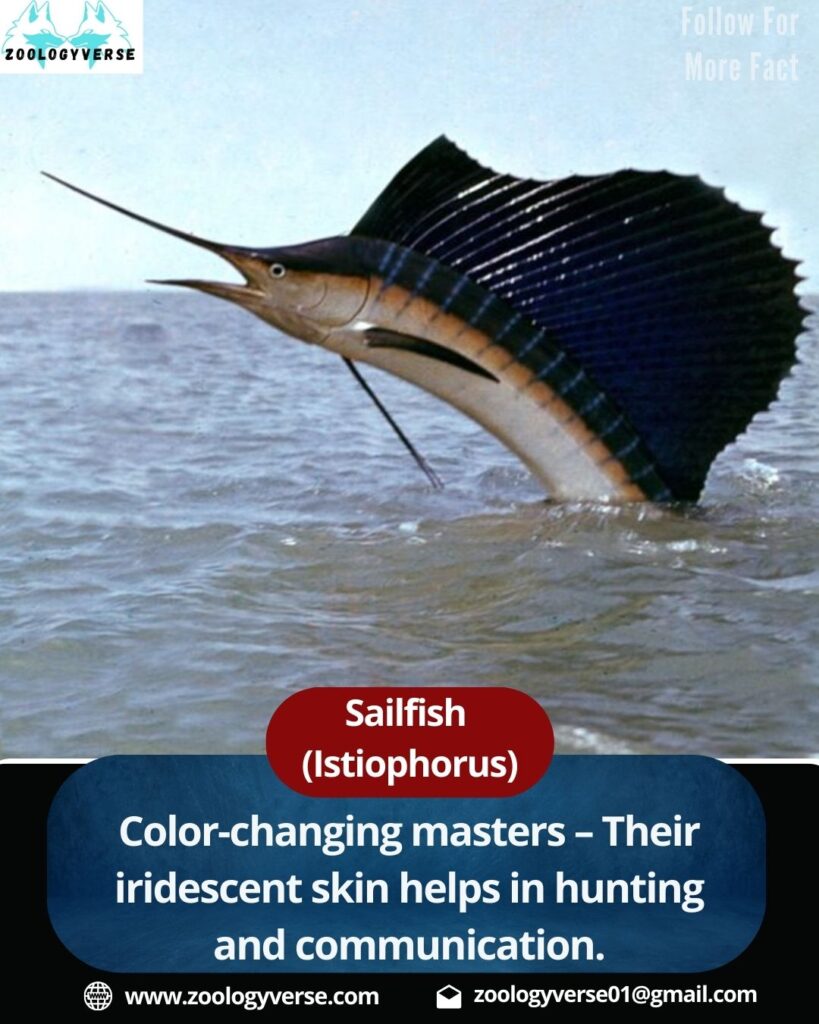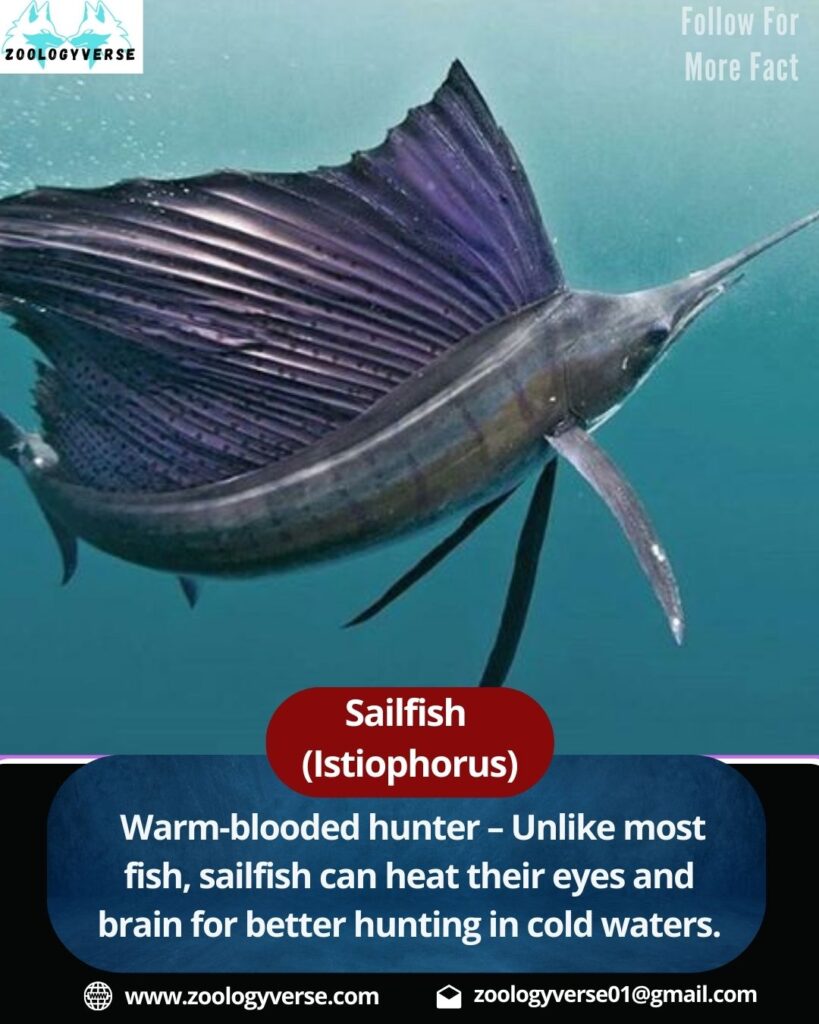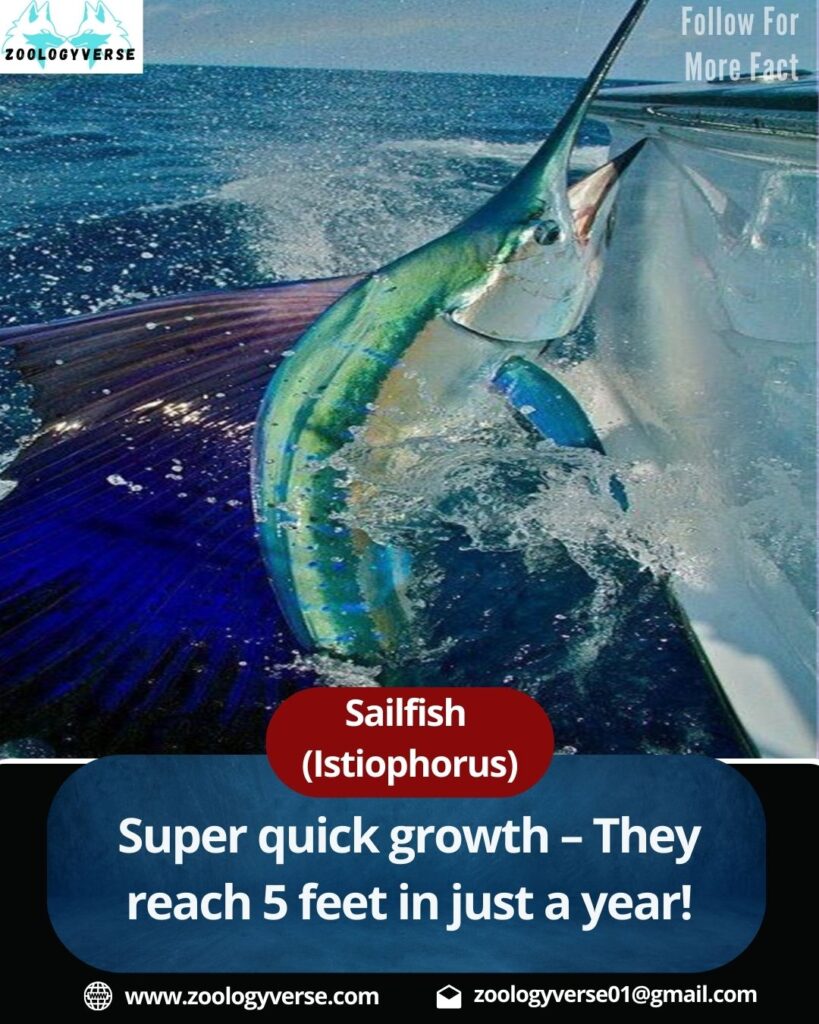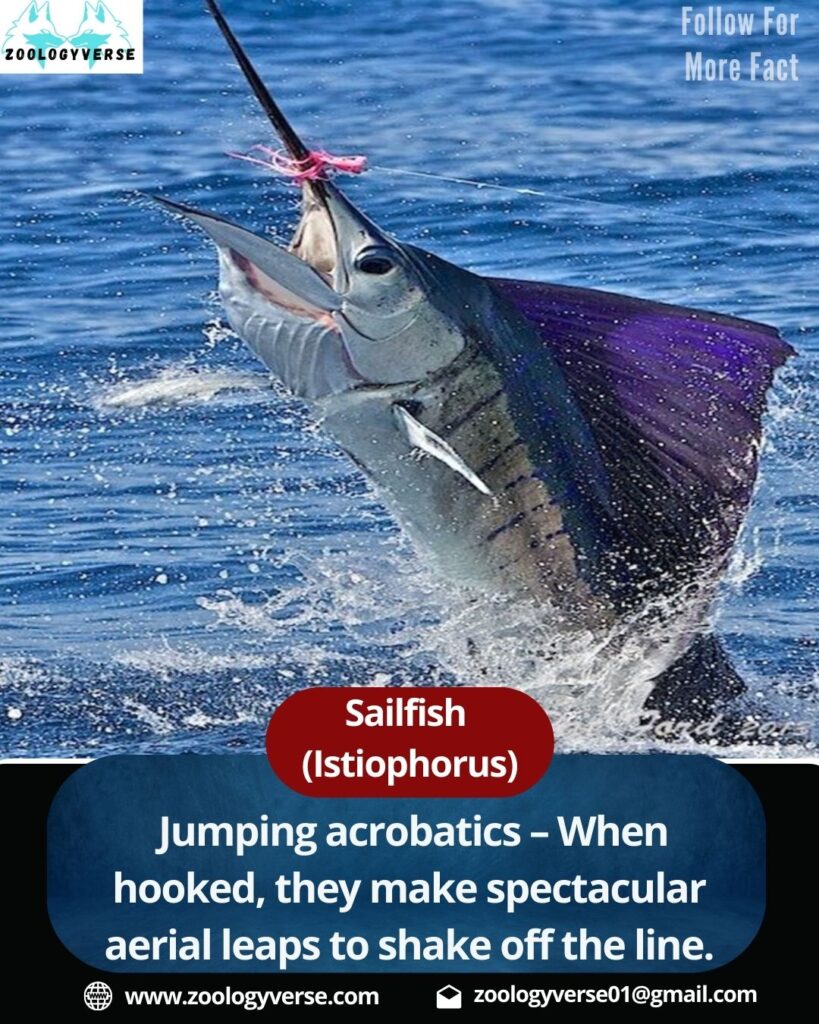Introduction
The sailfish (Istiophorus) is a magnificent marine predator, often celebrated as the fastest fish in the ocean. With its striking sail-like dorsal fin and elongated, spear-like bill, this species is not only a spectacle to behold but also a formidable hunter. Found in warm and temperate waters worldwide, sailfish are known for their astonishing speed, acrobatic leaps, and cooperative hunting techniques. Whether you are a marine enthusiast, an angler, or just curious about these remarkable creatures, this guide will dive deep into everything you need to know about sailfish!
Sailfish The Fastest Fish in the Ocean 🏎️🐟

The sailfish (Istiophorus) is one of the most iconic and fascinating fish in the ocean, known for its incredible speed, agility, and striking appearance. With its elongated body, sword-like bill, and majestic sail-like dorsal fin, this predator is a marvel of evolution, built for speed and precision hunting. It holds the title of the fastest fish in the world, reaching speeds of up to 68 mph (110 km/h), making it an apex predator in the open seas.
They belong to the Istiophoridae family, which includes marlin and swordfish, and they can be found in tropical and temperate waters worldwide. Their ability to change color through specialized skin cells, known as chromatophores, helps them communicate while hunting and serves as a method of camouflage.
Often referred to as the “cheetahs of the sea”, sailfish are highly social hunters that work in groups to herd and attack schools of fish using their sharp bills to slash through prey. Their hunting strategy, combined with their impressive acrobatics and intelligence, makes them one of the most efficient predators in marine ecosystems.
Beyond their biological significance, sailfish have become a prized catch in sport fishing due to their strength, endurance, and high-flying leaps when hooked. However, conservationists stress the importance of sustainable fishing practices to ensure their populations remain stable in the wild.
In this article, we’ll explore everything about sailfish—from their habitat and hunting techniques to their role in marine ecosystems and their interaction with humans. Whether you’re an angler, marine biologist, or simply fascinated by ocean life, sailfish are a species worth knowing! 🌊🐠
Taxonomic Classification of Sailfish 🧬🔬
| Rank | Classification |
|---|---|
| Kingdom | Animalia |
| Phylum | Chordata |
| Class | Actinopterygii |
| Order | Perciformes |
| Family | Istiophoridae |
| Genus | Istiophorus |
| Species | Istiophorus platypterus (Indo-Pacific sailfish) and Istiophorus albicans (Atlantic sailfish) |
They belong to the Istiophoridae family, which includes marlin and swordfish, all known for their speed and agility in the water.

Physical Characteristics 🏆🌊
They are instantly recognizable due to their distinctive body features:
- Sail-like dorsal fin: This prominent fin, which runs almost the length of its body, helps in maneuverability and intimidation of prey.
- Elongated bill (rostrum): Similar to a swordfish, it is used to slash through schools of fish, stunning them before capture.
- Streamlined body: Sailfish have a torpedo-shaped body that reduces drag, allowing them to move through the water at astonishing speeds.
- Color-changing ability: Their skin has iridescent blue and silver tones, which help them blend into their surroundings and communicate with other sailfish.
📏 Size: They can grow up to 11 feet (3.4 meters) long and weigh around 200 pounds (90 kg).
⚡ Speed: They can reach speeds of 68 mph (110 km/h), making them the fastest fish in the world!
Habitat and Distribution 🌍🌊
They are found in tropical and subtropical waters of the Atlantic, Indian, and Pacific Oceans. They prefer open waters (pelagic zones) but often come near coastal regions in search of food.
📌 Common Locations:
- Atlantic sailfish (Istiophorus albicans): Found in the Caribbean, Gulf of Mexico, and western Atlantic Ocean.
- Indo-Pacific sailfish (Istiophorus platypterus): Found in the Indian and Pacific Oceans, from the Red Sea to Australia and Japan.
They prefer water temperatures between 70°F to 85°F (21°C – 30°C) and are often found at depths of 30-200 feet.

Diet and Hunting Behavior 🦑🐠
They are carnivorous predators that feed on a variety of marine life, including:
✔️ Small fish (sardines, anchovies, mackerel)
✔️ Cephalopods (squid and octopus)
✔️ Crustaceans
They use their speed and teamwork to hunt efficiently:
- Herding prey: They work in groups to corral schools of fish, using their large dorsal fins to prevent escape.
- Slashing technique: They use their sharp bills to slash through prey, stunning or injuring them before feeding.
- Color signals: They change skin color to communicate with each other while hunting, helping them coordinate attacks.
Reproduction and Lifecycle 🐟🍼
They reproduce through external fertilization, where females release eggs into the water, and males fertilize them.
📌 Reproductive Facts:
- Spawning season: Occurs in warmer months (spring and summer).
- Egg production: A single female can release up to 4.5 million eggs in a season!
- Hatching time: The eggs hatch in 36-48 hours, and the larvae grow rapidly.
Juvenile sailfish grow incredibly fast, reaching nearly 5 feet (1.5 meters) within a year. They become sexually mature at 2-3 years old and can live up to 4-7 years in the wild.
The reproductive process of this remarkable marine predator follows a strategy that ensures the continuation of its fast and agile lineage. Typically found in warm oceanic waters, these creatures engage in external fertilization, where the female releases thousands to millions of eggs into the open sea while males simultaneously release sperm to fertilize them. This method increases the chances of successful reproduction, though many eggs and larvae fall prey to predators.
The juveniles grow rapidly, benefiting from warm temperatures and abundant food sources. They develop essential survival skills early, such as swift swimming and hunting techniques, allowing them to evade larger predators. Over time, they mature into highly efficient hunters, contributing to the balance of the marine ecosystem. Their reproductive strategy, combined with rapid growth, ensures their populations remain stable, provided environmental conditions remain favorable and human activities do not disrupt their habitats.

Sailfish and Human Interaction 🎣🚤
Sport Fishing
They are one of the most sought-after game fish in the world. Anglers prize them for their speed, strength, and high jumps when hooked. Catch-and-release fishing is common to protect sailfish populations.
Conservation Status 🛑
According to the IUCN Red List, sailfish are classified as “Least Concern”, but they face threats such as:
✔️ Overfishing – Accidental catches in commercial fisheries.
✔️ Climate change – Affecting migration patterns and food availability.
✔️ Marine pollution – Plastic waste and chemical runoff impacting their habitat.
Organizations like the IGFA (International Game Fish Association) promote sustainable fishing practices to ensure sailfish populations remain stable.
Amazing Facts About Sailfish 🏎️🐟
1. The Fastest Fish in the Ocean
They can reach speeds of up to 68 mph (110 km/h), making them the fastest fish in the world! Their streamlined bodies and powerful tails help them move swiftly through the water.
2. Their “Sail” Has a Purpose
The large dorsal fin, or “sail,” is not just for show! Sailfish use it to herd schools of fish, making it easier to catch prey. They also raise their sail when excited or to appear larger to predators.
3. They Can Change Color Instantly
They have special pigment cells (chromatophores) that allow them to change skin color within seconds. They use this ability to communicate, confuse prey, or show aggression.
4. They Hunt in Groups
Unlike many solitary fish, sailfish team up to hunt. They surround schools of smaller fish, taking turns slashing through with their sharp bills, stunning or injuring their prey before eating them.
5. They Grow Extremely Fast
They are one of the fastest-growing fish species. A baby sailfish can grow from less than 1 inch (2.5 cm) to over 4 feet (1.2 meters) in just one year!
6. They Are Highly Migratory
They travel thousands of miles across the ocean in search of food and warm waters. They are commonly found in tropical and subtropical regions of the Atlantic, Indian, and Pacific Oceans.
7. They Can Leap Out of the Water
They are known for their spectacular leaps (called breaching), which help them escape predators, catch prey, or shake off fishing hooks when caught.
8. They Are Related to Marlins and Swordfish
They belong to the Istiophoridae family, which includes marlin and is closely related to swordfish. However, sailfish have a more pronounced dorsal fin and a slightly smaller body.
9. They Use Their Bills to Hunt
Unlike swordfish, which stab prey, sailfish use their long, sharp bills to slash through schools of fish, stunning or injuring multiple prey at once before eating them.
10. They Are a Favorite Among Sport Fishermen
They are highly prized in sport fishing due to their speed, strength, and acrobatic jumps. However, many tournaments and fishing regulations enforce catch-and-release to help conserve their populations.
11. They Have Large Eyes for Hunting
They have exceptionally large eyes, giving them excellent underwater vision. This helps them spot and track fast-moving prey, even in dim light.
12. They Rarely Live More Than 4 Years
Despite their size and speed, sailfish have a relatively short lifespan, typically living 3-4 years in the wild, though some individuals can live up to 7 years.
13. Their Body Is Built for Speed
They have grooved bodies that allow their fins to retract, reducing drag while swimming. Their long, slender bodies and crescent-shaped tails give them extra propulsion.
14. They Are Apex Hunters
They are near the top of the ocean food chain, facing few natural predators. However, large sharks, orcas, and humans pose a threat to them.
15. They Are Not Endangered—Yet
While They are currently listed as “Least Concern” by the IUCN, they are still threatened by overfishing, habitat loss, and climate change. Many conservation efforts focus on sustainable fishing practices to protect their populations.

FAQs About Sailfish 🏎️🐟
1. What makes sailfish the fastest fish in the ocean?
Sailfish are built for speed thanks to their streamlined bodies, powerful tails, and retractable dorsal fins. They reduce drag in the water and use their muscular, torpedo-like shape to reach speeds of up to 68 mph (110 km/h), making them the fastest fish in the world.
2. Where are sailfish found?
Sailfish are found in warm tropical and subtropical waters across the Atlantic, Indian, and Pacific Oceans. They prefer open waters but sometimes venture near coastal areas to hunt.
3. What do sailfish eat?
Sailfish primarily feed on small schooling fish like sardines, anchovies, and mackerel, as well as squid and crustaceans. They hunt in groups, using their sharp, elongated bills to slash through schools of fish and stun their prey.
4. How do sailfish use their sail-like dorsal fins?
The large dorsal fin, or “sail,” is usually folded down while swimming to reduce drag. However, sailfish raise their sails when hunting, possibly to herd prey or make themselves look larger to intimidate predators. It is also used in communication with other sailfish.
5. Can sailfish change color?
Yes! They can change their skin color instantly thanks to specialized chromatophores. This helps them communicate with other sailfish, confuse prey, or signal aggression or excitement.
6. Are sailfish related to swordfish?
Sailfish and swordfish are both members of the Istiophoridae family, which includes marlin as well. However, sailfish are smaller and have a more pronounced dorsal fin, whereas swordfish have a thicker, more powerful bill and lack the large sail-like fin.
7. How big do sailfish get?
They typically grow between 5.7 to 11 feet (1.7 to 3.4 meters) in length and can weigh up to 220 pounds (100 kg). However, most sailfish caught in sport fishing weigh between 40-100 pounds (18-45 kg).
8. Do sailfish migrate?
Yes! They are highly migratory and travel across vast ocean distances in search of warmer waters and food sources. Their migration patterns are influenced by ocean temperatures, prey availability, and seasonal changes.
9. Are sailfish dangerous to humans?
They are not aggressive toward humans, but their long, sharp bills can cause accidental injuries, especially when caught on fishing lines. Their high-speed jumps and powerful movements can be dangerous if handled carelessly.
10. Are sailfish endangered?
They are currently classified as “Least Concern” by the IUCN, but they face threats from overfishing, habitat destruction, and climate change. Sustainable fishing practices are essential to keep their populations stable. Many areas enforce catch-and-release regulations to help protect them.
They are truly one of nature’s most incredible marine predators. With their unmatched speed, unique hunting techniques, and stunning appearance, they remain a symbol of power and agility in the ocean. Whether you’re a diver, angler, or marine life enthusiast, understanding these magnificent creatures helps us appreciate and protect them for future generations.
The ocean is home to some of the most remarkable and efficient predators, and this species stands out as one of the fastest and most agile. With its streamlined body, impressive speed, and unique hunting techniques, it dominates its environment with precision. Its ability to adapt and thrive in warm waters showcases the wonders of marine evolution. Whether admired for its swift movements or its striking appearance, this incredible creature remains a symbol of power and grace beneath the waves. Understanding and conserving such species is crucial to maintaining the delicate balance of marine ecosystems, ensuring future generations can continue to witness its extraordinary capabilities. 🌊🐟
The ocean’s fastest swimmer is a true marvel of nature, showcasing incredible speed, agility, and adaptability. As one of the top predators in its ecosystem, it plays a crucial role in maintaining the balance of marine life. Its streamlined body, elongated dorsal fin, and remarkable hunting techniques make it a fascinating subject for marine biologists and ocean enthusiasts alike.
From its rapid growth in the juvenile stage to its extraordinary bursts of speed while chasing prey, this species exemplifies the beauty and efficiency of evolution. Its ability to thrive in warm waters across the world’s oceans highlights its adaptability and resilience. However, despite its strength and speed, it faces challenges such as habitat degradation, climate change, and overfishing, which threaten its population.
Conservation efforts, including sustainable fishing practices and marine protected areas, are essential to preserving this species for future generations. By understanding and appreciating its significance in the marine food chain, we can ensure that this remarkable predator continues to roam the oceans, captivating scientists, anglers, and wildlife enthusiasts alike.
🔗 For more amazing animal facts and wildlife insights, visit: ZoologyVerse 🌿🌍
Follow us on Instagram and Facebook
